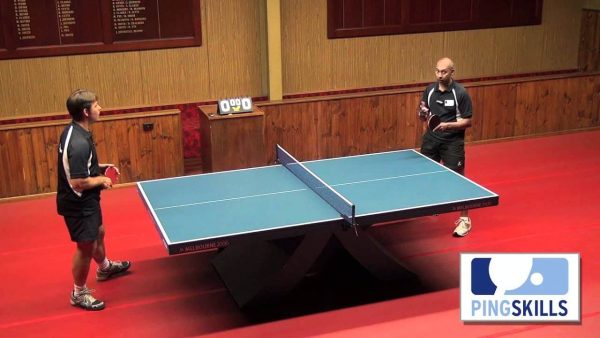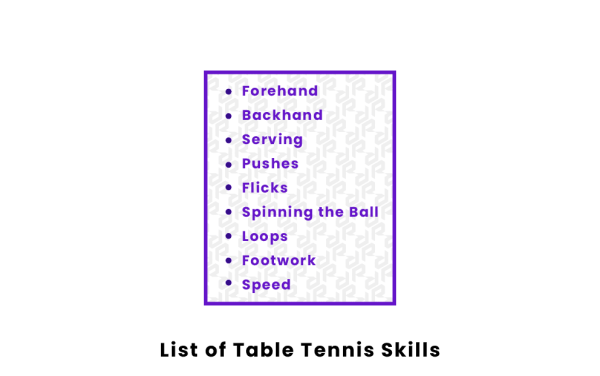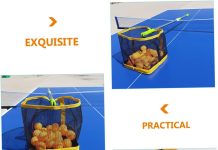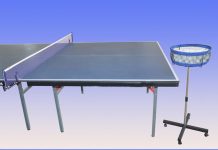Let’s be honest, table tennis is a game of lightning-fast reflexes, strategic thinking, and impeccable hand-eye coordination. But amidst all the techniques and tactics, there is one skill that stands out as the true game-changer. A skill that can single-handedly turn the tide of any match, leaving opponents bewildered and spectators in awe. As we explore the world of table tennis, we come to realize that the most crucial skill in this exhilarating sport is none other than the art of spin. Whether it’s mastering the delicate sidespins or unleashing awe-inspiring topspin shots, the ability to manipulate the spin of the ball is what separates the novices from the champions in table tennis. Join us as we unravel the secrets behind this pivotal skill and discover how it can transform your game from good to extraordinary.
Review contents
Technique
When it comes to mastering the art of table tennis, having a solid technique is crucial. It forms the foundation for every other aspect of the game and allows us to execute our shots with precision and control.
Footwork
Good footwork is the key to success in table tennis. It enables us to move quickly and efficiently around the table, allowing us to reach and return even the most challenging shots. By constantly adjusting our position and balance, we can maintain optimal stability and maximize our hitting power.
Grip
Choosing the right grip is essential for achieving the desired control and power in our shots. There are primarily two common grips in table tennis – the shakehand grip and the penhold grip. The shakehand grip is more popular and provides versatility in shot selection, while the penhold grip offers better control and speed for quick exchanges close to the table. Whichever grip we choose, it should feel natural and allow us to manipulate the racket fluidly.
Strokes
Mastering various strokes is vital in table tennis, as it allows us to adapt to different game situations. The three basic strokes are the forehand drive, backhand drive, and forehand push. These strokes form the foundation of our shot repertoire and can be combined with advanced techniques such as loops, smashes, and chops to create a diverse and powerful arsenal of shots.
Speed and Agility
In the fast-paced world of table tennis, speed and agility play a crucial role in our ability to outmaneuver opponents and gain an advantage.
Quick Reflexes
Having quick reflexes allows us to react swiftly to unexpected shots and return them with precision. By honing our reflexes through training and practice, we can anticipate our opponent’s moves and execute lightning-fast counterattacks.
Fast Movement
Table tennis requires us to move quickly and efficiently across the table. By improving our footwork and agility, we can reach more shots and maintain an optimum position for accurate and powerful returns. Quick and controlled movement allows us to take advantage of openings and put pressure on our opponents.
Hand-Eye Coordination
Good hand-eye coordination is fundamental in table tennis. It enables us to accurately gauge the angle, speed, and spin of the incoming ball, allowing us to make split-second adjustments and respond accordingly. Regular drills and exercises that focus on coordination can significantly enhance our ability to read and react to our opponent’s shots.
This image is property of qph.cf2.quoracdn.net.
Spin and Control
The ability to generate spin and control the ball is crucial in table tennis. It gives us an edge over opponents by creating more unpredictable shots and making it challenging for them to anticipate our returns.
Spin Generation
By mastering the correct technique and racket angle, we can generate various types of spin, such as topspin, backspin, and sidespin. Effective spin generation allows us to control the ball’s trajectory and put our opponents under tremendous pressure, forcing them to make errors or provide us with opportunities to attack.
Spin Variation
Being able to vary the spin on our shots is an invaluable skill in table tennis. By manipulating the racket angle and brushing the ball differently, we can create deceptive shots that are difficult to read and return. This variation in spin adds an element of surprise to our game and allows us to consistently challenge our opponents.
Ball Placement
Strategic ball placement is crucial in table tennis. A well-placed shot can force our opponents out of position, making it harder for them to return the ball with accuracy. By learning to control the depth, angle, and speed of our shots, we can exploit weak areas of our opponent’s game and gain a significant advantage.
Serve and Return
The serve and return are the starting points of every rally in table tennis. Mastering these aspects of the game can give us an immediate advantage and disrupt our opponent’s rhythm.
Power and Accuracy in Serves
A powerful and accurate serve can instantly put our opponents on the defensive. Whether it’s a fast and low serve or a high and spinny one, the serve sets the tone for the rally and allows us to control the game from the very beginning. By varying our serve placement and spin, we can make it difficult for our opponents to anticipate and return effectively.
Reading Opponent’s Serve
Being able to read our opponent’s serve is a valuable skill in table tennis. By carefully observing their racket angle, body position, and ball toss, we can anticipate the type of spin and placement they are likely to use. This anticipation gives us a split-second advantage in preparing our positioning and stroke selection for a successful return.
Effective Return Strategies
A well-executed return can put us in a strong position to win the point. It’s essential to respond with accuracy and control, either by playing a safe and controlled shot or by seizing the opportunity to attack. By analyzing our opponent’s weaknesses and adjusting our return strategy accordingly, we can consistently keep them under pressure and gain an advantage in the match.
This image is property of qph.cf2.quoracdn.net.
Mental Focus
Table tennis is not just a physical game; it requires a high level of mental focus and concentration. The ability to stay calm, make quick decisions, and stay focused throughout the match can be the difference between victory and defeat.
Concentration
Maintaining concentration during a match is essential. By blocking out distractions and focusing on the game at hand, we can better anticipate our opponent’s moves, react quickly, and maintain consistency in our strokes. Concentration also helps us stay mentally engaged, enabling us to adapt to changing game situations and make strategic decisions.
Anticipation
Anticipating our opponent’s shots is a valuable skill that can give us a significant advantage. By studying their playing style and shot patterns, we can predict their next move and adjust our positioning and stroke selection accordingly. Anticipation allows us to move more efficiently and respond with greater accuracy, putting us in a favorable position to win points.
Decision Making
Quick decision making is crucial in table tennis, where split-second judgments can make all the difference. Assessing the type and speed of the incoming shot, choosing the appropriate stroke or placement, and executing it with confidence requires sharp decision-making skills. By practicing decision-making in training and matches, we can improve our ability to choose the right shots and adapt to different game scenarios.
Adaptability
The ability to adapt to different styles of play and modify techniques during a match is a crucial skill in table tennis. It allows us to respond effectively to our opponent’s tactics and maintain control over the game.
Adjusting to Different Styles of Play
In table tennis, we encounter players with various styles and strategies. By being adaptable, we can adjust our game plan to counter their strengths and exploit their weaknesses. Whether it’s facing a defensive player, an aggressive attacker, or a player specializing in spin, being able to adapt our strokes and tactics accordingly is key to success.
Modifying Techniques during a Match
During a match, we may encounter situations that require us to modify our techniques on the fly. This could involve adjusting the speed, spin, or placement of our shots to disrupt our opponent’s rhythm or exploit opportunities. By being flexible and open to changing our approach, we can continuously put pressure on our opponents and keep them guessing.
Changing Strategies
Sometimes, a change in strategy is necessary to turn the tide in a match. Recognizing when to alter our game plan, such as transitioning from a defensive to an aggressive style or vice versa, can catch our opponents off guard and give us a significant advantage. Adapting our strategy to suit the game situation can help us regain control and secure the win.
This image is property of qph.cf2.quoracdn.net.
Tactical Awareness
Developing tactical awareness in table tennis allows us to read the game, analyze our opponent’s weaknesses, and exploit openings to gain an upper hand.
Reading the Game
Reading the game involves observing our opponent’s playing style, shot selection, and patterns. By understanding their strengths and weaknesses, we can adjust our tactics to capitalize on their vulnerabilities. Reading the game also involves recognizing momentum shifts and adjusting our strategy accordingly to maintain an advantage.
Analyzing Opponent’s Weaknesses
Identifying and attacking our opponent’s weaknesses is a key component of tactical awareness. By analyzing their stroke technique, footwork, or susceptibility to certain shots, we can exploit those weaknesses to gain points. This can involve targeting specific areas of the table or employing specific shots to force errors or create openings.
Exploiting Openings
Being able to recognize and exploit openings in our opponent’s defenses is crucial. These openings may be subtle, such as a slight delay in footwork or a momentarily mispositioned racket. By capitalizing on these opportunities with well-placed shots or unexpected spins, we can force errors or create scoring opportunities for ourselves. Tactical awareness allows us to maximize our chances of success by capitalizing on these fleeting moments.
Physical Fitness
Table tennis may be considered a sport of finesse, but physical fitness plays a crucial role in our overall performance. Maintaining a high level of fitness enhances our endurance, speed, and flexibility, enabling us to perform at our best.
Endurance
A game of table tennis can be physically demanding, requiring us to maintain a high level of energy and concentration throughout the match. Good endurance allows us to sustain the intensity of our play, giving us an advantage over opponents who may tire more quickly. Regular cardio exercises and endurance training can significantly improve our stamina on the table.
Speed
Speed is a vital component of table tennis, both in terms of movement and stroke execution. By improving our agility and quickness, we can react faster to incoming shots and reach balls that may seem out of reach. Speed training drills and exercises help us enhance our overall speed, allowing us to move swiftly across the table and execute shots with greater speed and power.
Flexibility
Flexibility is essential to maintain a smooth and fluid motion in our strokes. It allows us to generate a full range of motion in our joints and muscles, resulting in more precise and consistent shots. Regular stretching exercises, such as yoga or dynamic stretches, can improve our flexibility and reduce the risk of injuries associated with the fast-paced and dynamic nature of table tennis.
This image is property of i.ytimg.com.
Training and Practice
Continuous training and practice are essential for honing our table tennis skills and improving our overall performance. Consistency and focused practice are key to achieving long-term progress.
Consistency in Training
Consistency is crucial in improving our table tennis skills. Regular training sessions help to reinforce muscle memory and develop good habits, resulting in more consistent and reliable shots. By dedicating a set amount of time each week to training, we can steadily improve our technique, footwork, and game strategy.
Drills and Exercises
Specific drills and exercises are designed to target different aspects of our game. Whether it’s practicing footwork drills, honing our serve and return skills, or working on specific strokes, structured exercises help us isolate and improve specific areas of our game. By incorporating various drills into our training routine, we can develop a well-rounded skill set.
Match Simulation
Simulating match conditions during practice is essential for preparing ourselves mentally and physically. By playing practice matches against opponents of similar or higher skill levels, we can experience realistic game situations, test our strategies, and identify areas for improvement. Emphasizing match simulation in our training helps us develop the mental toughness and composure required to perform well in competitive matches.
Experience and Match Play
Experience and exposure to different levels of competition play a vital role in our growth as table tennis players. Learning from matches and building mental toughness can help us elevate our game to new heights.
Exposure to Different Levels of Competition
Competing against players of varying skill levels allows us to broaden our understanding of the game and adapt our playing style accordingly. By participating in local, regional, and national tournaments, we expose ourselves to different playing styles, tactics, and levels of intensity. This exposure helps us gain valuable experience and develop strategies to overcome various challenges.
Learning from Matches
Every match provides an opportunity to learn and improve. Reflecting on our performances, analyzing our strengths and weaknesses, and identifying areas for improvement allows us to continually refine our game. Whether we win or lose, there are always lessons to be learned from each match, helping us grow and progress as players.
Building Mental Toughness
Table tennis can be mentally challenging, especially in high-pressure situations. Building mental toughness is crucial in maintaining composure and performing at our best. By developing strategies to stay calm, focused, and resilient during matches, we can handle the pressure and make better decisions under stress. Mental toughness also allows us to bounce back from setbacks and maintain a positive mindset throughout the ups and downs of a match.
In conclusion, table tennis is a dynamic and intricate sport that requires a diverse set of skills and attributes. From mastering technique to developing mental focus and adapting to different game situations, each aspect of the game contributes to our overall performance. By continuously working on all these areas and striving for improvement, we can take our table tennis game to new heights and enjoy the camaraderie and thrill of the sport with friends and opponents alike. So grab your paddle, find a table, and let the exhilarating world of table tennis unfold before you!
This image is property of www.rookieroad.com.

























![Best Outdoor Dartboards [Reviews and Buying Guide 2024] Best Outdoor Dartboards](https://gamersets.com/wp-content/uploads/2022/12/Best-Outdoor-Dartboards-100x70.jpg)

![Best Mini Air Hockey Table [Reviews & Buying Guide 2024] Best mini air hockey table](https://gamersets.com/wp-content/uploads/2022/10/Best-mini-air-hockey-table-100x70.jpg)







